Where
Location
Redditch, Worcestershire, England
Description
A SuDS retrofit project completed in 2003, which included swales, detention basins and a constructed wetland. The original design involved traditional drainage, however, during construction it was discovered that this would not work. SuDS were used to overcome the problems and to remove the need for a pumping station (with the ongoing maintenance costs that involves).
The school development was originally designed with traditional drainage that flowed to a pumping station where it was pumped to a sewer. However, one playground area was not actually able to drain by gravity to the pumping station.
The SuDS approach drains the site by following the gradient downhill to Ipsley stream, reducing the need for pumping (with its associated costs) and also removes the annual charge for a sewer connection.
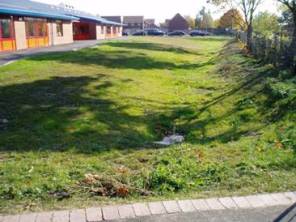 |
|
Figure 1 Main drive storage basin with controlled outfall (Bob Bray) |
SuDS used
-
Swales
-
Detention basins
-
Constructed wetland
-
Rainwater harvesting
How it works
The use of SuDS was proposed to overcome the gradient and remove the need for the pumping station and associated ongoing maintenance costs. The SuDS scheme follows the contours of the site and drains downhill to the Ipsley Stream (removing the annual charge for the sewer connection).
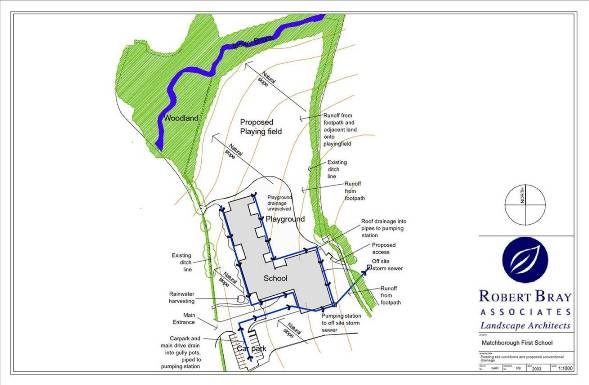 |
|
Figure 2 Initial drainage proposal (Bob Bray) |
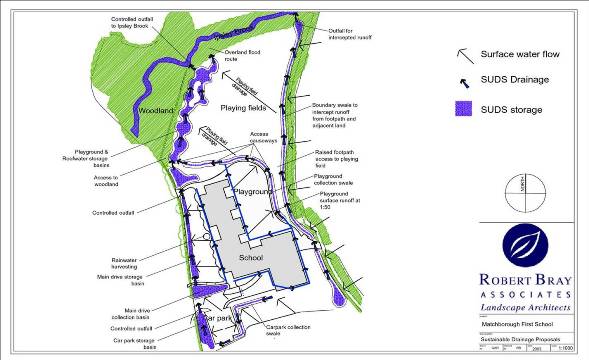 |
|
Figure 3 SuDS outline proposal (Bob Bray) |
Specific details
Swales collect overland flows from an adjacent site and the runoff from the car park and playground, providing source control. The main driveway is drained to an extended detention basin. These systems connect to a constructed wetland, which also takes runoff directly from the roof and provides amenity as well as well as useful educational resource.
The system was designed to cope with a 1 in 100 year return period storm event, and overland flow routes were provided for events exceeding this. The SuDS system has also been designed to provide a valuable amenity and teaching resource for the school.
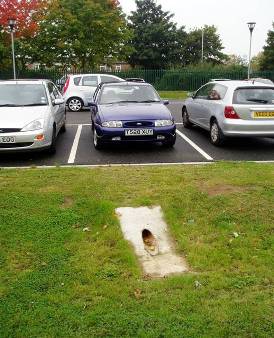 |
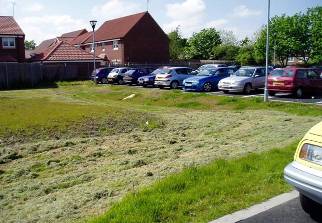 |
|
Figure 4 Car park inlet (Bob Bray) |
Figure 5 Car park collection swale (Bob Bray) |
Benefits & achievements
Benefit: Maintenance costs. The maintenance of the newly constructed system is planned to be a marginal extension to the landscape contract required for the school grounds, with regular inspections undertaken by the school caretaker. Hence maintenance costs for SuDS are expected to be marginal compared with the conventional drainage costs of sewer connection (around £3200 p.a.) and pumping station maintenance (around £800 p.a.).
Benefit: Amenity and educational resource. The wetland provides added amenity to the school and also provides an educational resource. Risk is managed by appropriate design and education of school children.
Barrier: Adoption. The highways authority was initially unwilling to adopt SuDS for road drainage.
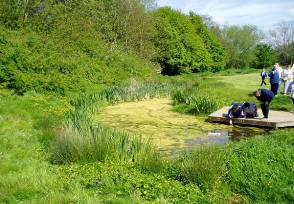 |
|
Figure 6 Dipping platform on a wetland (Bob Bray) |
Challenges & lessons learnt
-
Incorporating and allowing SuDS early in the development design will reduce costs
-
SuDS can effectively control overland flows and land drainage flows from adjacent sites
-
SuDS are cost-effective compared to conventional drains
-
Well-considered design provides valuable amenity and habitat for marginal cost
-
Water safety issues need not prevent the use of SuDS
-
Retrofitting SuDS to existing sites is feasible.
The information on Matchborough First School was provided by the designer: Robert Bray Associates



